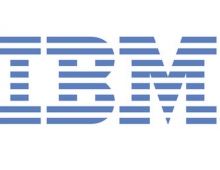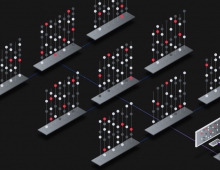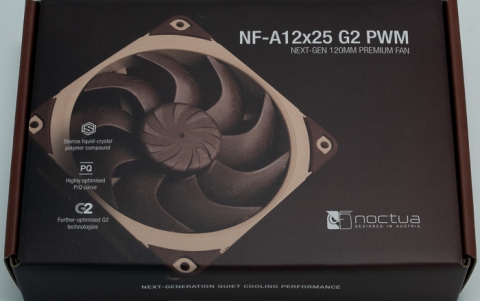IBM Develop World's Tiniest Nanophotonic Switch to Route Optical Data Between Cores in Future Chips
IBM scientists today took another advance towards sending information inside a computer chip by using light pulses instead of electrons by building the world?s tiniest nanophotonic switch.
The switch is an important building block to control the flow of information inside future chips and can significantly speed up the chip performance while using much less energy.
"This new development is a critical addition in the quest to build an on-chip optical network," said Yurii Vlasov, manager of silicon nanophotonics at IBM's TJ Watson Research Center. "In view of all the progress that this field has seen for the last few years it looks that our vision for on-chip optical networks is becoming more and more realistic".
Today's announcement is another advance in their quest to develop next generation high-performance multi-core computer chips which transmit information internally using pulses of light traveling through silicon instead of electrical signals on copper wires.
In a paper published in the journal Nature Photonics, IBM unveils the development of a silicon broadband optical switch, another key component required to enable on-chip optical interconnects. Once the electrical signals have been converted into pulses of light, this switching device performs the key role of directing traffic" within the network, ensuring that optical messages from one processor core can efficiently get to any of the other cores on the chip.
The IBM team demonstrated that their switch has several critical characteristics which make it ideally suited to on-chip applications. First, the switch is extremely compact. As many as 2000 would fit side-by-side in an area of one square millimeter, easily meeting integration requirements for future multi-core processors.
Second, the device is able to route a huge amount of data since many different wavelengths or colors" of light can be switched simultaneously. With each wavelength carrying data at up to 40 Gb/s, it is possible to switch an aggregate bandwidth exceeding 1 Tb/s -- a requirement for routing large messages between distant cores. Last but not least, IBM scientists showed for the first time that their optical switch is capable of operating within a realistic on-chip environment, where the temperature of the chip itself can change dramatically in the vicinity of "hot-spots," which move around depending upon the way the processors are functioning at any given moment. The IBM scientists believe this temperature-drift tolerant operation to be one of the most critical requirements for on-chip optical networks.
An important trend in the microelectronics industry is to increase the parallelism in computation by multi-threading, by building large scale multi-chip systems and, more recently, by increasing the number of cores on a single chip. For example the IBM Cell processor which powers Sony?s PlayStation 3 gaming console consists of nine "brains," or cores, on a single chip. As users continue to demand greater computing performance, chip designers plan to increase this number to tens or even hundreds of cores.
This approach, however, only makes sense if each core can receive and transmit large messages from all other cores on the chip simultaneously. The individual cores located on multi-core microprocessors communicate with one another over millions of tiny copper wires. However, this copper wiring would simply use up too much power and be incapable of transmitting the enormous amount of information required to enable massively multi-core processors.
IBM researches are exploring an alternative solution to this problem by connecting cores using pulses of light in an on-chip optical network based on silicon nanophotonic integrated circuits. Like a long-haul fiber-optic network, such an extremely miniature on-chip network will transmit, receive, and route messages between individual cores that are encoded as a pulses of light. It is envisioned that using light instead of wires, as much as 100 times more information can be sent between cores, while using 10 times less power and consequently generating less heat.
The report on this work, entitled "High-throughput silicon nanophotonic wavelength-insensitive switch for on-chip optical networks" by Yurii Vlasov, William M. J. Green, and Fengnian Xia of IBM?s T.J.WatsonResearchCenter in Yorktown Heights, N.Y. is published in the April 2008 issue of the journal Nature Photonics.
In November 2005, IBM scientists demonstrated a silicon nanophotonic device that can significantly slow down and actively control the speed of light.
In December 2006 an analogous tiny silicon device was used to demonstrate buffering of over a byte of information encoded in optical pulses a requirement for building optical buffers for on-chip optical networks.
In December 2007, IBM scientists announced the development of an ultra-compact silicon electro-optic modulator, which performs the job of converting electrical signals into the light pulses, a prerequisite for enabling on-chip optical communications.
"This new development is a critical addition in the quest to build an on-chip optical network," said Yurii Vlasov, manager of silicon nanophotonics at IBM's TJ Watson Research Center. "In view of all the progress that this field has seen for the last few years it looks that our vision for on-chip optical networks is becoming more and more realistic".
Today's announcement is another advance in their quest to develop next generation high-performance multi-core computer chips which transmit information internally using pulses of light traveling through silicon instead of electrical signals on copper wires.
In a paper published in the journal Nature Photonics, IBM unveils the development of a silicon broadband optical switch, another key component required to enable on-chip optical interconnects. Once the electrical signals have been converted into pulses of light, this switching device performs the key role of directing traffic" within the network, ensuring that optical messages from one processor core can efficiently get to any of the other cores on the chip.
The IBM team demonstrated that their switch has several critical characteristics which make it ideally suited to on-chip applications. First, the switch is extremely compact. As many as 2000 would fit side-by-side in an area of one square millimeter, easily meeting integration requirements for future multi-core processors.
Second, the device is able to route a huge amount of data since many different wavelengths or colors" of light can be switched simultaneously. With each wavelength carrying data at up to 40 Gb/s, it is possible to switch an aggregate bandwidth exceeding 1 Tb/s -- a requirement for routing large messages between distant cores. Last but not least, IBM scientists showed for the first time that their optical switch is capable of operating within a realistic on-chip environment, where the temperature of the chip itself can change dramatically in the vicinity of "hot-spots," which move around depending upon the way the processors are functioning at any given moment. The IBM scientists believe this temperature-drift tolerant operation to be one of the most critical requirements for on-chip optical networks.
An important trend in the microelectronics industry is to increase the parallelism in computation by multi-threading, by building large scale multi-chip systems and, more recently, by increasing the number of cores on a single chip. For example the IBM Cell processor which powers Sony?s PlayStation 3 gaming console consists of nine "brains," or cores, on a single chip. As users continue to demand greater computing performance, chip designers plan to increase this number to tens or even hundreds of cores.
This approach, however, only makes sense if each core can receive and transmit large messages from all other cores on the chip simultaneously. The individual cores located on multi-core microprocessors communicate with one another over millions of tiny copper wires. However, this copper wiring would simply use up too much power and be incapable of transmitting the enormous amount of information required to enable massively multi-core processors.
IBM researches are exploring an alternative solution to this problem by connecting cores using pulses of light in an on-chip optical network based on silicon nanophotonic integrated circuits. Like a long-haul fiber-optic network, such an extremely miniature on-chip network will transmit, receive, and route messages between individual cores that are encoded as a pulses of light. It is envisioned that using light instead of wires, as much as 100 times more information can be sent between cores, while using 10 times less power and consequently generating less heat.
The report on this work, entitled "High-throughput silicon nanophotonic wavelength-insensitive switch for on-chip optical networks" by Yurii Vlasov, William M. J. Green, and Fengnian Xia of IBM?s T.J.WatsonResearchCenter in Yorktown Heights, N.Y. is published in the April 2008 issue of the journal Nature Photonics.
In November 2005, IBM scientists demonstrated a silicon nanophotonic device that can significantly slow down and actively control the speed of light.
In December 2006 an analogous tiny silicon device was used to demonstrate buffering of over a byte of information encoded in optical pulses a requirement for building optical buffers for on-chip optical networks.
In December 2007, IBM scientists announced the development of an ultra-compact silicon electro-optic modulator, which performs the job of converting electrical signals into the light pulses, a prerequisite for enabling on-chip optical communications.





















